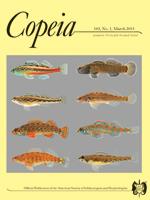Settlement-stage larvae of the widespread apogonid Gymnapogon urospilotus are described and illustrated from specimens captured with crest nets at Moorea, Society Islands. Identification was confirmed by COI mitochondrial DNA analysis. Otoliths of the larvae had no settlement mark, indicating they had not previously settled, and 33–40 presumed daily rings. The larvae are transparent with large orange/red blotches on the tail, and limited melanophores on head and pelvic fins. The larvae have very long pelvic-fin rays (40–50% standard length [SL]) with black tips and contrasting white bands, and limited inter-ray membranes. They are apparently unique among teleost fishes in having a strongly serrate urohyal. These serrations disappear after settlement. Critical speed of the larvae was measured in a swimming chamber. Larvae of G. urospilotus are the largest (19–24 mm SL), oldest (33–40 days), and fastest (>36 cm s−1) known apogonids at settlement. Photos of larvae of G. urospilotus from Guam, Ryukyu Islands, and Indonesia reveal they swim 2–3 m above coral reefs at night with the pelvic rays spread wide, presumably looking for settlement habitat. They are very conspicuous and may be mimicking small lionfish. In contrast, adults have never been seen alive on the reef. The largest reported adult G. urospilotus is 37 mm SL, which implies that this species undergoes a major portion of its growth as a pelagic larva, a life history pattern that also occurs in some reef gobiids.
How to translate text using browser tools
16 February 2015
A Coral-reef Fish with Large, Fast, Conspicuous Larvae and Small, Cryptic Adults (Teleostei: Apogonidae)
Jeffrey M. Leis,
Olivia Meyer,
Amanda C. Hay,
Michelle R. Gaither
ACCESS THE FULL ARTICLE





